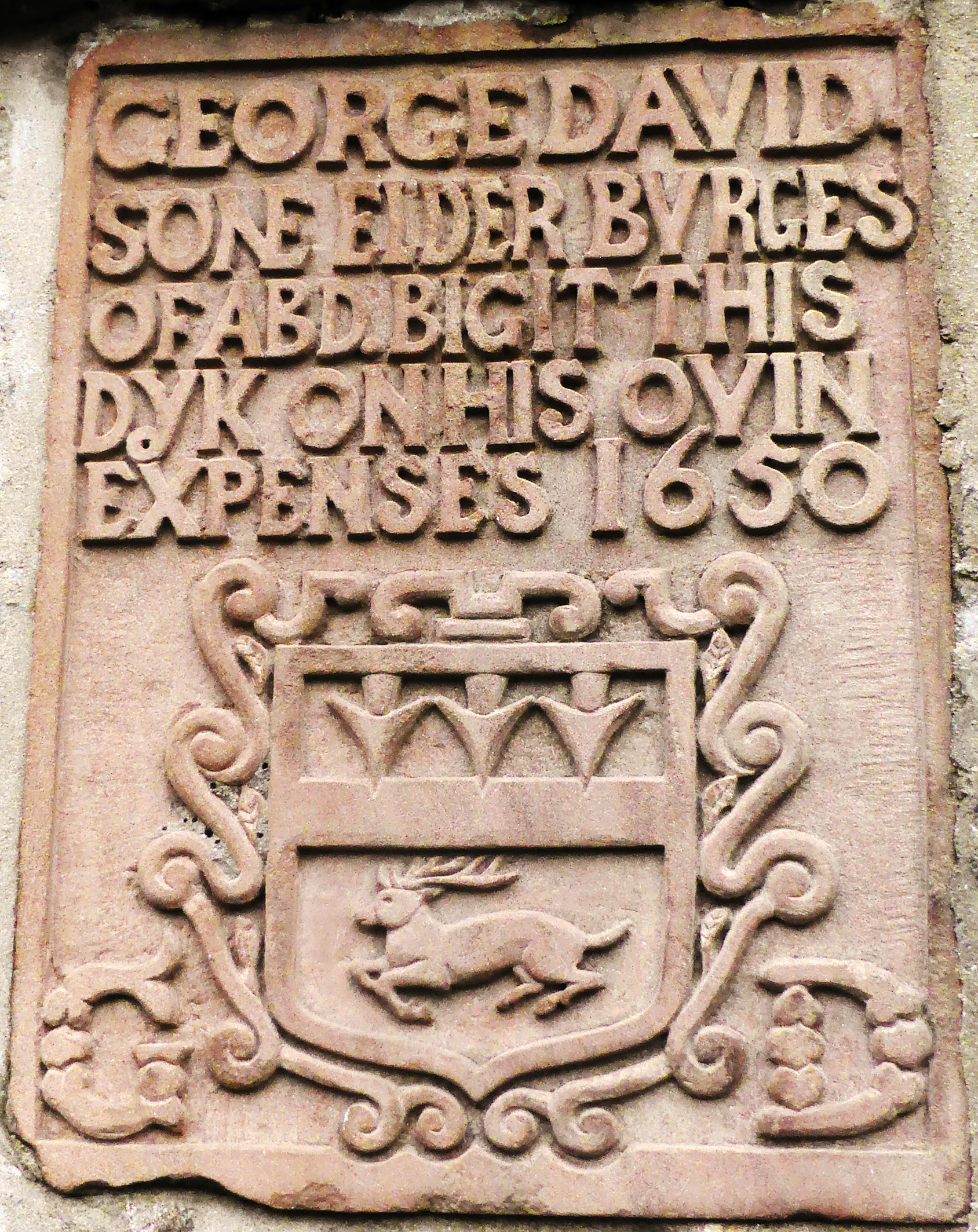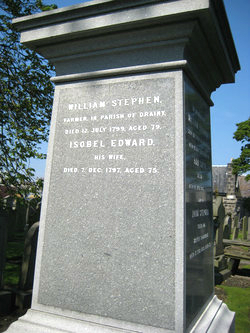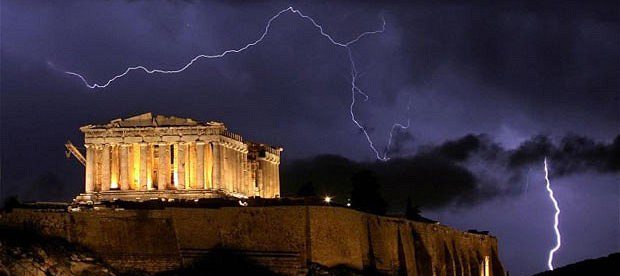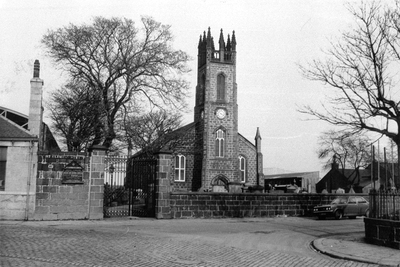St Clements Church Footdee 1498 ~
The St Clements Church is a fine Building with a Tall Clock & Bell Tower with 6-Pinnacles and 4-Pinnacles at the top of each Corner of the Building. It dominated the Skyline of Footdee in many Paintings & Photographs.

Church Built in 1828 and Site of an earlier Church which served the Fishing Community of Fittie (or Futty, now Footdee).
The 1st Historical evidence for the Church reputed to have been in existence by at least 22nd June 1467 when it was then being Thatched. 1st Erected to serve the small Fishing Settlement at Futty., although it is suggested that this may have been a Chapel rather than Church. Surprisingly little is known about the Church in the Medieval Period and its occurrence in the Historical Record is Scanty. All Whitefishers in Fittie paid 2s from each Master of a Boat having 2-Lines and 1s for each Boatman in order to support the Church. The reference at this date, however, is only to the collection of Sums of Money from the Fisher-folk for the ‘Kirk Wark‘. Whilst in 1510 they contributed 1s for every Line towards the costs of celebrating Mass twice a week. On 9th September 1505 ‘Sir’ Thomas Lammingtone was appointed by the Burgh Council to be Chaplain of the Church. After the Reformation, the Chapel fell into Decay. Certainly on 8th March 1560 Aberdeen Burgh Council Granted Licence to Patrick Menzies to occupy the Chapel, on the Provision that he kept it Water-tight. By the early 1630s the Church had completely fallen out of use. Moreover it would seem that it had not been used for some time: by this point there was a growing movement in Aberdeen to see the Church reinstated. The impetus for this seems to have come from Robert Barrone, Minister of St Nicholas Church. On 22nd June 1631 he noted that certain Townspeople had voluntarily contributed 5400-Merks for the Provision of a Minister to Fittie Church. He asked the Council to agree to ‘the necessitie of the Plantatioun.’. The Council agreed and an entry at the start of Council Register Vol-62 lists the names of those who had contributed to this undertaking and in many ways it represents the Great & Good from Aberdeen at the time. Amongst those listed are the Artist George Jamesone, William Guild, Patron, Minister & Principal of King’s College & Alexander Jaffray, Provost & Diarist. A Catechist was Settled there. Thus the Church was re-established: in 1650 George Davidsone, Burgess, built a Dyke to enclose the Graveyard of the Church. A Stone Plaque was erected to Commemorate this.

Plaque on Churchyard Wall:
George Davidson, elder Bvrges of ABD; Bigit this Dyk on his Ovin Expenses 1650 with his Coat of Arms & Initials below.
George Davidson of Pettens. Pettens was a Farm just North of Balmedie, but George Davidson acquired a Large Estate covering the area near Kingswells, Newhills & Bucksburn. It is not known when he was born, nor who his Parents were. He never married and was probably illiterate. Despite this he was a Burgess of the City of Aberdeen and amassed a substantial amount of Wealth, part of which he used to extend his Estate. However, most of his Wealth was used to Fund Projects for the Benefit of others. Travelling home from Aberdeen one day he saw a man nearly drown in attempting to cross the Buxburne (which Flows through the Aberdeen suburb of Bucksburn to join the River Don). This moved him to have a Stone Bridge Built, including the Provision of Money for its Upkeep. In addition, he repaired the Bridge at Insch, built the Chapel at Newhills and the Walls around St Clement’s Churchyard in Aberdeen. Apart from this Type of Beneficence he also left Endowments to the Ministers of both St Nicholas & St Clement’s Churches.
His Memorial in St Nicholas Churchyard (Back Wynd Wall)
“To the Eternal Memory of George Davidson of Pettens, a man truly notable for the Integrity of his Life, and profuse Liberality towards the Poor, and for his Piety towards God, and who deserved very well from the Church and all the Commonwealth, and from the City of Aberdeen. This man, besides many Donations for the perpetual help of the Poor & Publick uses, caused the Bridge of Inche to be repaired, and the Bridge of Buxburne to be built of a notable Structure. He gifted to the Church of Aberdeen the Lands of Pettens & Bogfairlie, with certain Sums of Money, for the Perpetual use of a Preacher of God’s Word there; he also caused to Build the Church of Newhills, and, for the more increase of the Kingdom of God, by a singular example & preparative, he Dedicated & Mortified the said Lands of Newhills also, for the Maintenance of the Ministers of the Gospel thereat. He died in the year 1663.”
On 22nd April 1785 the Council were informed that the Church was in ‘immediate need of some necessary Repairs.’ They appointed 4-Tradesmen to Report on the Church. The Tradesmen concluded that ‘the Walls might be repaired, though in several places they were bad, but as the Roof & Slatting were so Rotten & Spent it was their unanimous opinion that it would be very improper to think of Repairing.’ By the 5th October the situation was now so bad that Mr Fullerton, the Minister, wrote to the Council asking for permission to stop Preaching there due to the danger to himself and his Congregation. On the 22nd October the Council agreed that Fullerton could Preach to his Congregation in the College (Greyfriars) Kirk as a Temporary solution until plans for a New Church in Fittie were Completed & Executed. Despite the temporary nature of this Arrangement it continued for 2-yrs: each Sunday the Inhabitants of Fittie would attend Service led by Fullerton in the old Greyfriars Kirk between 12 & 2pm. It was only when Fullerton died that one of the Congregation, Baillie John Copland, took the Lead in the situation.
On the 2th0 September 1787 Copland offered to Pay for a New Church, designed on Plans approved of by the Council. The New Church Building was completed in 1788. During the rebuilding the Churchyard Dykes were altered from Davidson’s 1650 Originals. The were straightened in Line with the Road leading to Pocra Quay & Garvock’s Wynd, also at this time part of the old Churchyard was removed from the Church and became part of the New Road leading in Front of the Church & Yard. On 14th January 1789 a Council Committee remitted to consider the rebuilding work reported that it was now finished. It was only 38-yrs later that the Church was again in need of rebuilding. On 19th June 1827 the Rev Dr John Thomson requested £1500-1600 from the Council to rebuild the Church. In this instance the rebuilding was needed because the Church was by now too small for the Congregation. Thomson was willing to pay the Bill in the meantime in return for a Legal Voucher from the Council. The Council approved of his Plans On the 25th September 1827 the Provost laid Plans for the New Church before the Council. They noted that the New Church was ‘to be erected in an Area to the Eastward of the Present Church’. George Duncan’s Tender for the Stonework was the lowest at £865 and James Bryce’s was the Lowest for the Wright Work at £999. One year later on 11th September 1828 the Town’s Chamberlain, Mr Hardie, reported to the Council that the Church was Finished at a cost of £1800 and some additional Expenses. Hardie noted that it had been necessary to rebuild part of the Churchyard Walls and finish them off with Cast-iron Railings & Gates to the Front (although it was remitted to the Council’s Standing Committee to decide finally if they were to be Cast Iron, or Malleable Iron). Thomson eventually agreed to pay the whole Bill of £1864, despite having agreed to only pay £1600, but with the Stipulation that the Town was pay any further Costs (Council Register Vol-72, f.23r). On the 7th April 1829 the Council set the new Burial Rates for the Churchyard. Interment of under 12s cost £4, those aged between 12 & 21 were set at £6 and £8 for over 21s. Lying Stones cost £2-5s, Head Stones varied from 10 to 20s and the |Cost of opening a new Lair was set between £3 & £5, depending on its position within the Churchyard.
Council meeting, 22nd October 1824: The Council approved the Sale by Public Roup in way of Feu of 2-Pieces of Ground adjacent to the Church of Footdee, reserving a space of 100-ft east of the Churchyard for the purpose of adding to the Burial Ground should it prove necessary. The said Lots were taken by George Yeats, Advocate in Aberdeen, on behalf of James Forbes & Co, Rope & Sailmakers, for the yearly Feu Duty of £32 per Scots Acre. (81r – 81v)
Like most of the Churches in Aberdeen St Clement’s was affected by the Disruption in 1843. A Roll dated February 1843 Records the Names of around 1000 members of the Cngregation who adhered to the notions that would underpin the later Disruption. Alexander Spence, then Minister, was one of those who walked out of the Established Church. St Clement’s Free Church, later West St Clement’s, soon had around 800 communicants. When the Free Church in Castle Terrace nr fish Street became known as West St Clement’s the Original Church of St Clement’s became known as East St Clement’s. Although the United Free Church reunited with the Church of Scotland in 1929 2-Churches in Fittie continued to Operate until 1963 when both Congregations were re-United in St Clement’s Church. One of the Key reasons for the reunion of the Congregations was dwindling Numbers attending Service. This continued to be a problem and by the 1980s the Congregation numbered around 500, compared to the 2000 Recorded in East St Clement’s in 1875. The Church remained in use until 1987, when the last Service there was held on 24th May. The last Minister, when the Congregation was dissolved, was Arthur Jones.
The Church, Designed by Local Architect John Smith, is 3-Bay & Symmetrical in Gothic Style with an Advanced Central Pinnacled, Crocketted & Balustraded 4-Stage Entrance Clock Tower & Belfry. Built of Coursed & Snecked Granite Rubble with Smooth Rubble Dressings, and a Grey Slate Roof. It stands within a Churchyard containing mostly 19thC Gravestones, some with decorative Carvings and many with Nautical Inscriptions. Later alterations were made by Mathew’s & Mackenzie 1885. The Boundary Wall dates from 1650 with later Additions: on the North there is a carved Plaque with inscription ‘George Davidson Elder Burgess of Aberdeen Bigit This Dyk on his Own Express 1650‘. It was enlarged 1788 and again 1819. The Church was Refurnished and an Organ was placed in it in 1874. The Church Building today is in Private Hands whilst the Churchyard remains under City Council Care. See also and for Plaques on the Church. The Graveyard includes the Grave of Benjamin Grimmer, Royal Naval Reserve, Killed during WW2 and 5-WW1 Commonwealth War Graves.
St Clement, whose Feast is on the 23rd November, is the Patron Saint of Blacksmiths. Some say he died a natural death, others that he was Martyred, by being cast into the Sea with an Anchor about his neck; and when his friends or admirers went in search of his Body, the Sea retired 3-miles, and discovered a beautiful little Church, of Angelic Erection, in which was a Stone Chest containing his Body, and the Fatal Anchor.
The ‘Town’ of Futty, Fittie or Footdee has always been seen as distinct & separate from the adjacent Burgh of Aberdeen. In part this reflects its Geographical situation, lying on the North Bank of the Dee at some distance from the Nucleus of Aberdeen, but also its Origins and the very different way of Life led by its Inhabitants who were dependent entirely upon Fishing for their Livelihood. The earliest Inhabitants of Futty probably lived in the Vicinity of the Church, but Harbour Developments in the 19thC made necessary some re-Housing in the ‘Squares‘, near the Site of the old Defensive Blockhouse.


Among the most eminent people buried there is David Grant, the Composer of the famous Psalm “Crimond“. A Plaque at the door entrance gives these details, while near the South Entrance there is a large Granite Coffin which is more like a Tomb, to the William Duthie, Merchant & Shipowner and who’s Family gave the Duthie Park to Aberdonians to enjoy. Another is of the Hall Family, of the famous Alexander Hall Shipbuilders.
John Duthie, Shipbuilder, Canal Terrace – (Virginia St to Garvock St)
The Organ built by Messrs Forster and Andrews, Hull, 1875, ‘has a Brass attached inscribed ‘Presented to St Clement’s Church
by John Duthie, Esq, Shipbuilder, 1875‘
John Duthie, Shipbuilder had 6-sons & 3-daughters. John was born in 1817, William in 1822, Alexander in 1824, Robert in 1831, James in 1835 and George in 1838.
The daughters were called Ann, Helen & Mary.
John Duthie Sons & Co., Shipbuilders, York Place. h.2 Wellington Street (c.1830)
The late Mr John Duthie (wrote Provost Daniel Mearns in the “Futtie Kirk Bazaar Book” ; Aberdeen, 1896 , p . 36) was perhaps the largest-hearted man in Footdee. He defrayed the cost of the Session House & otherwise contributed largely to the Church Schemes. His brother William took a great interest in the Poor of the District and he left the sum of £1000 to the Managers of the Church for the Meal & Coal Fund

Old William Stephen Shipbuilder was declared Bankrupt at 69-yrs and then moved to Arbroath, but did not survive the change very long. He too died in 1838, on 21st November, and was buried in the Family Burial Ground in Footdee Churchyard, Aberdeen. His life was eventful, but rather tragic, in that the success he won was entirely undermined by the failures of his Family and he was obliged to spend the last 10-yrs of his life as a Guest of one of his younger sons. We gather that he bore his misfortunes with gentleness & resignation. His wife, apparently, had at 1st some difficulty in forgiving him for his failure but, in a later letter from Edinburgh, John declares that she appeared to be showing more affection for his father. The old Lady, who had a somewhat sharp-featured face, was probably rather trying. However, those of his Family who remained were very much attached to the Old Shipbuilder, especially John, who was devoted to his father. While in Edinburgh John had his parents’ Portraits – which are still extant – Painted, on Commission for Alexander, who paid 6-Guineas for the pair.

Five Trenches were excavated in advance of a Warehouse Development started in 1996 in the Vicinity of St Clement’s Church. Four of the Trenches contained Windblown Sand up to a depth of 3M. This Sand was the remains of Sand Dunes which had occupied the Site since at least the Medieval Period. One Trench consisted of a Depth of 1.5M of the same Windblown Sand on top of a layer of Organic Loam. This was found to contain Plough Marks & Medieval Pottery, suggesting that an attempt had been made to reclaim some of the Dunes for Cultivation. The Organic Loam was a maximum of 0.3M Deep; this suggests that the reclamation lasted only for a short Period, and that this area then reverted to a Dune System.

